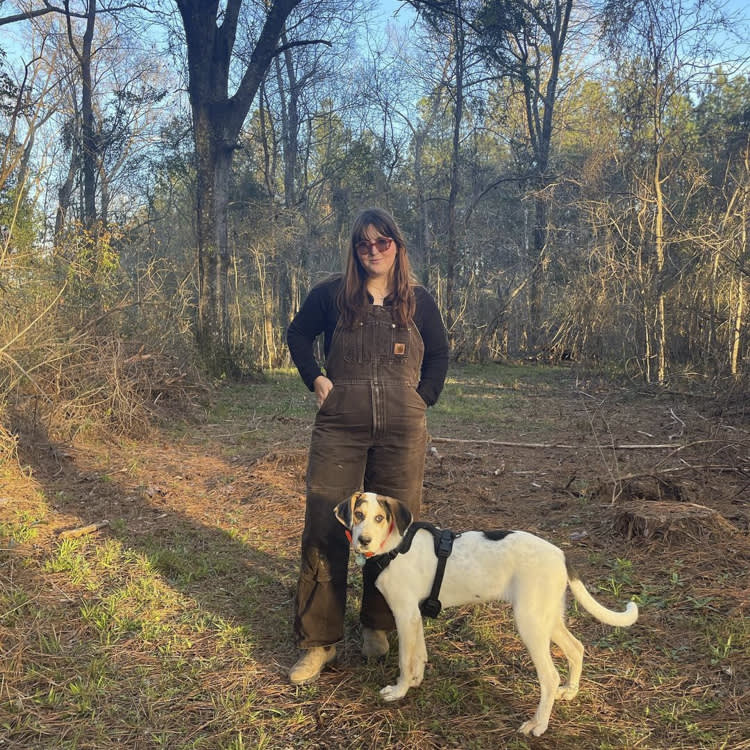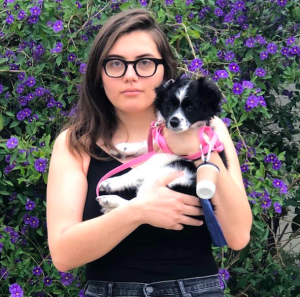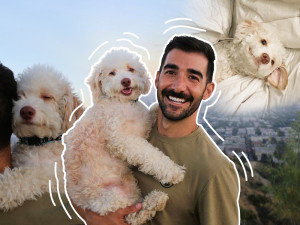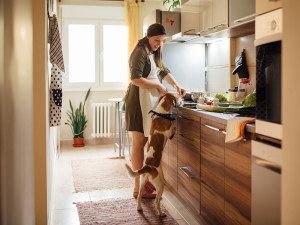Estelle Lemmler and Hank Are Blissfully Living off the Land
The fashion designer turned sustainable farmer on trading city for country life, adopting a working dog, and harvesting farm-to-table treats.
Sustainability comes first for Estelle Lemmler. After nearly eight years working in fashion design in New York City, the New Orleans native returned to her roots to start Fat Cat Farmopens in new tab with her family in nearby Mississippi. Lemmler always saw food (cooking it, procuring it, eating it) as both an escape and a chance to make environmentally conscious choices, something that seemed very difficult to do within the waste-creating world of clothing production. Even after rising through the ranks and becoming the lead designer on a project for Totokaelo and working on Need Supply’s in-house menswear, she realized the need to work in food would never stop nagging at her.
Now, after a move back to New Orleans and the purchasing of acres of farmland in Mississippi, Lemmler is finally in the place to put these desires into motion. By her side is Hank, a Great Pyrenees and Rhodesian Ridgeback mix, who is there not only to help her enjoy farm life, but to do work of his own on the farm (and snack on the food they grow).
Tell me about what exactly inspired you to start a farm.
I had been working in menswear design for almost eight years when I noticed that I couldn’t really make a big difference in terms of sustainability, no matter how hard I tried. Every chance I had at any company I worked at to make things more “green” or more “sustainable,” it was always out of the budget or not truly a sustainable option in terms of ultimately just creating waste.
Frustrated by this, I started spending much more time focusing on my other interests, which were mainly cooking and eating. Going to the greenmarkets in NYC had always been a big part of my routine, but it quickly transformed into my escape. I started applying for farming apprenticeships, but convincing people you can withstand hard hours of physical labor on a farm with a strictly fashion and art school background was a lot harder than I ever imagined. I mean, it does sound pretty silly.
How much do you spend on your pet per year?
What ended up being your “in” to the food selling and growing world?
I knew if I wanted to be taken seriously about my interest in farming, I’d have to take a job locally that would show I could carry around heavy things and cared about agriculture. So I quit my design job and applied to be a cashier at a local whole animal butcher shop (The Meat Hook) that was down the street from my Brooklyn apartment, and I somehow got the job. A few weeks went by and then I was promoted to Produce and Grocery Buyer. I was suddenly talking to farmers, distributors, makers, chefs, and home cooks all day long, having endless opportunities to learn.
When I watched people purchase things from sustainable sources and farmers that were actively doing their part to fight climate change, it confirmed my suspicion that farming was a way that I could actually create a positive impact on climate change, connect with my community more, and give myself hope for the future. I kept working as a buyer for two years while my family and I saved up to buy our own farm in Mississippi, which is an hour away from my hometown of New Orleans. I moved down here in October of 2021, and now I am actively rehabilitating the soil and gearing up to farm full-time on our farm this spring!
How did you come to adopt Hank?
Making the move to New Orleans was a huge jump. I left my job, my New York friends, coworkers, mentors, my community, AND ended a three-and-a-half year relationship. To say I was lonely would have been an understatement. I had all the time in the world now to focus on the farm and be outdoors the whole day, but I found myself feeling very, very isolated. I knew it was the perfect time to take on raising a puppy, because it could be my main focus and would naturally make me very, very happy during a time when I could use a little boost of joy. I also realized living alone in the country has its spooky factors and a large dog might be both nice and necessary to keep around.
Were you looking for any particular breed of dog to suit the farm lifestyle?
I started researching large-breed farm dogs — their personalities, their needs, and who would be the best breed to have guard our livestock one day. Great Pyrenees kept coming up, and I had met a lot of GPs visiting other farms in the past. They’re great with chickens and other livestock, are nocturnal which makes them awesome nighttime guards, and they are loud, frequent barkers to alert their owner if there’s any sort of danger. Plus, they are sweet as can be. The only thing was that I worried about their heavy coats in the south.
I would sit on Petfinder every evening to find one that would fit my needs, and one day I saw a litter of Great Pyrenees and Rhodesian Ridgeback mixed-breed puppies. I learned more about Rhodesian Ridgebacks, and realized that they fit a lot of the other qualities I was looking for in a companion — smart, loyal, independent, active — also frequently called “velcro” companion dogs. Although the two breeds are not commonly crossed, it seemed like the strange but perfect fit for me. Hank’s got a painted coat, so I didn’t have to worry about the Great Pyrenees’s coat being too much for the weather, either!
The local SPCA that I adopted him from was full to the brim with puppies after Hurricane Ida, so the adoption process was very easy. I knew he was the one the second I met him; he’s as friendly as can be and loves to give kisses. His spots look like freckles, he’s got the longest tail I’ve ever seen, and personality-wise he’s a real hoot. He will do anything to make me laugh, and he loves to be by my side. We bonded pretty quickly, too.
Have you had any big issues (or triumphs!) with training him and adjusting him to your lifestyle?
Hank has definitely been a handful, which I expected. But maybe I didn’t fully imagine him to be 45 lbs by the time he was 22 weeks old. He is both the smartest dog I’ve ever had and the most active dog I’ve ever had. If I’m not keeping both his brain and his body busy during the daytime, there’s no getting him to sleep at night (thank you nocturnal Great Pyrenees traits).
I love how active my own life has become through adopting Hank — even on days when the world feels like too much, I still have to go outside on a long walk. On days when we’re at the farm, we always walk the entire property’s perimeter and through the woods (it’s 15 acres) both when we first get there and when we leave. It teaches Hank how to survey the property for changes, any predators or intruders (we’ve got a lot of deer, wild turkeys, wild boar, and I’ve even seen cougar tracks!).
When I’m farming he sits and watches me, helps dig up the yard in OK places, or chews on a cow ear from our local butcher shop. Walking the property each time we’re out there allows him to do a lot of scent work, running, and recall training — which all really tires him out. When we drive back to the city, he sleeps the whole hour long drive home.
I love your video of Hank eating the radishes. Does he have a favorite treat that you’ve grown?
Radishes are absolutely Hank’s favorite farm treat. I don’t know why, but whenever I harvest them he can barely wait for me to clean them off to eat them. He honestly eats a lot of vegetables — broccoli, carrots, kale — but I am working on training him to “wait” for his serving and not to just harvest it himself, otherwise I could have a pretty big problem on my hand once I start growing more vegetables in the spring.
I know you’re interested in sustainable farming. Do you look into sustainable pet care options? Have you found any difficulties with living an eco-friendly life with a pet?
Yes! Adopting a dog has come with a lot of sustainability choices along the way. Where do toys come from? What are they made out of? What is their longevity and what will happen to them when they no longer work or have been chewed to bits? Adopting a large breed dog also comes with lots of growing adjustments — Hank outgrows his collar every month, and has gone through three sizes of harnesses already. I do my best to find the most sustainable option with everything I purchase for Hank, typically choosing quality materials and knowing that things can be given to other smaller dogs we know or donated back to a shelter.
Choosing Hank’s food was just as important as choosing where my own food comes from. Food of any kind can make a positive impact on the environment when we responsibly choose where it comes from. Also, working in a whole animal butcher shop taught me a lot about how to really use every part of an animal. Since Hank is a big boy who needs lots of protein and healthy nutrients, I definitely cook a lot of his food — I always use chicken scraps and bones to make chicken stock to put in with his dry food, and I feed him offal from grass-fed beef or pasture-raised chicken when it’s available to me. It’s never been hard for me to include Hank’s life choices into my own sustainable practices, and I hope one day I can make all of his food from scratch.
What do you think has been the biggest difference between having pets in a regular home vs. having them on a farm?
I’ve had dogs my whole life, but they’ve always been more calm breeds and strictly house pets (think Golden Retrievers and small Terriers). Hank is truly a working dog. He needs a job to stay active and happy. When we go to the farm, I tell him “It’s time to go to work” and he runs into the back seat of the car pretty eagerly. I’m glad I had a rough idea of what I’d be getting myself into by being able to research his breeds before going through with the adoption. I know he will be the most happy dog in the world when we can be at the farm full time.
Is there anything you think that city-dwelling pet owners would find surprising about the farm lifestyle?
My biggest takeaway as a city dweller, ex-apartment dweller, and now farm dweller is that it’s so important to really know that you can 100% give a dog the life they deserve when you are choosing what breed to adopt. There are some large, active, working dogs that really just won’t be happy in an apartment lifestyle. I am so lucky to be able to give Hank the attention, the space, and the amount of activity that he needs.
When owning a larger, more active dog, it can be easy to get frustrated with how much they can get into when they aren’t staying busy enough, but I always remind myself how lucky I am to get to spend Hank’s lifetime with him, and it pushes me to come up with new ways to be active together. It’s a huge commitment that has really improved my life for the better, but I know I could have never done this when I lived in a 1,000-square-foot walk-up apartment in New York.
One of Hank’s littermates was recently returned to the shelter after the family that adopted her realized that she was going to be too large to be around their small children, and that she wasn’t getting enough activity. I am currently trying to adopt her as well (fingers crossed), and while it’s exciting for me and Hank, rehoming can be really difficult on both the dog and the adopters. There are so many great resources to research breeds before adopting a dog and I can’t recommend it enough.





